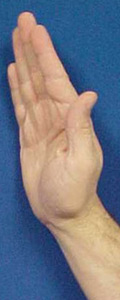Exercise and other Complementary Therapies for Inflammatory Arthritis Pain
An HSS Community Education & Outreach Feature
While advances in the development of targeted medications for inflammatory arthritis have transformed the way these diseases are treated and significantly improved patients' lives, there are also a number of non-medical approaches you can take to feel better.

From physical and occupational therapy to exercise, acupuncture, and mind-body therapies, people living with inflammatory arthritis are taking steps to get moving and live more full lives.
Before starting any of the regimens below, make sure to discuss them with your rheumatologist. Remember that these strategies work best in addition to (not instead of) medication.
Mobility is key
When you have inflammatory arthritis pain, it can be tempting to feel like you should move less. But in fact, the opposite is often true: gentle movements, leading up to more regular exercise, can actually have a beneficial effect by reducing the pain and discomfort of inflammatory arthritis. When you sit for long periods, your joints can become stiff, and prolonged inactivity may even lead to muscle atrophy.
Incorporating regular physical activity into your life is imperative when you have inflammatory arthritis. Ideally, your personal fitness program should include stretching exercises to support mobility and reduce stiffness, strengthening exercises to protect and stabilize your joints, and cardiovascular activity to support your heart and promote the flow of oxygen-rich blood to all parts of your body.
If you're not already engaged in a regular fitness regimen and want to know where to begin, have a conversation with your primary care physician or rheumatologist, who may recommend that you see a physical therapist to learn the best exercises for your type of arthritis. If your arthritis is affecting your hands, wrists, elbows, or shoulders, you may also consider seeing an occupational therapist or certified hand therapist, who is specially trained to focus on the upper extremities of the body – such as exercises for rheumatoid arthritis affecting the hands and fingers.
Which exercises are best for inflammatory arthritis?
While one exercise regimen does not work for every person with inflammatory arthritis, here are some activities that many people enjoy and find helpful for relieving their symptoms. See a physical or occupational therapist to learn how to do these activities properly while maintaining good alignment and posture.
Strengthening exercises
There's no need to rush out and join a gym. You can begin getting stronger at home.
- Start with sitting to standing exercises, rising from a chair using the muscles of your legs and then sitting down again.
- For the upper body, you can begin by lifting cans of soup or light dumbbells (two to five pounds each is sufficient).
- Some people enjoy the resistance therapy offered by elastic exercise bands.
- Pilates is excellent for strengthening your core, which supports the rest of your body.
Stretching exercises
Yoga is a great way to learn gentle stretching of all parts of the body while also strengthening your muscles. Chair yoga is a safe way to do it if you are concerned about balance issues or other limitations. Yin yoga is a gentle, slow-moving form of yoga that focuses on holding certain stretches for three minutes or more.
Exercises for arthritis in the hands
Many people whose hands are affected by inflammatory arthritis compensate for their discomfort by developing a narrowed or "tear-drop" grasp, rather than the more functional "c-shaped" grasping pattern (see picture below).

Narrowed grasp

Functional "C" position
An occupational therapist can teach you exercises to promote mobility in your hand to enhance your ability to grasp. "Tendon-gliding" exercises (see below) also improve the movement and function of tissues in your fingers, hands, and wrists. Your therapist can show you how how to do these exercises.

Open Palm

Roof Top

Straight Fist

Full Fist

Hook Fist
Cardiovascular exercise
People living with the discomfort and progression of inflammatory arthritis may be advised to avoid high-impact activities such as running. Low- or no-impact exercises that may be better choices include:
- Walking.
- Hiking, using poles for support and balance if needed.
- Swimming and water exercises, which relieve the effects of gravity on the joints while offering gentle resistance.
T'ai chi is a series of progressive, slow movements that promote mobility as well as balance. Many people living with arthritis find it to be very helpful.
Schedule breaks throughout your day for rest if you are moving, and for movement if you are mostly sedentary. For example, if you are sitting at a computer for several hours, make small body movements every 15 to 20 minutes, such as stretching your hands, arms, and neck in your chair. Every 45 minutes, get up to move the larger joints of your body, such as using the bathroom or getting a glass of water.
"No pain" does not mean "no gain"
There is a misconception that exercise needs to cause pain or discomfort in order for you to know that it's working. But this is not necessarily true. If you continue to do the kinds of exercises that benefit people with inflammatory arthritis, you will see improvements in other ways: less pain, better function, less exertion required to move, and more mobility.
Aligning with a physical or occupational therapist who understands your needs and preferences can help you set goals that work for you. You don't need to go to therapy sessions forever; even just two to three sessions to put together a movement plan for you can have lasting benefits. Occupational therapists can also fit people with customized splints or match them with adaptive equipment to make it easier and more comfortable to get through the day.
Restoring energy flow: acupuncture for inflammatory arthritis
Many people have reported relief of their symptoms after receiving acupuncture for rheumatoid arthritis, psoriatic arthritis, and other forms of inflammatory arthritis. Acupuncture involves the insertion of very thin needles into key points in the body, with the goal of restoring the flow of energy, or "qi."
Note that the acupuncture energy points for arthritis may actually not be in the same location where you may be feeling pain, and that's okay; a licensed acupuncturist knows where to insert the needles to achieve the greatest benefit to meet your needs. Acupuncture has also been shown to help relieve muscle tension, reduce stress , and promote better sleep. "Tui na" massage therapy is a similar ancient Chinese technique that activates certain acupressure points without needles. Both approaches appear to have the most benefit when your inflammation is not at its peak (such as during a flare), but rather when your symptoms have calmed a bit.
The mind is the master
Meditation and psychotherapy (particularly cognitive behavioral or "talk" therapy) have helped many people with inflammatory arthritis by addressing the anxiety and stress that can exacerbate symptoms. Cognitive behavioral therapy can help you reframe your relationship with your arthritis symptoms so you don't let them consume your thoughts.
Meditation and measured breathing have been shown to reduce stress and the effects of inflammation by activating your vagus nerve, which helps you respond better to stress. Try practicing this technique eight times, twice a day:
- Breathe deep into your belly for four counts.
- Hold for seven counts.
- Exhale for eight counts.
Take control of your arthritis
It can be easy to let painful, chronic arthritis symptoms take the joy out of life, but you don't have to. With guidance from licensed professionals, you can get moving again and implement mind-body approaches that let you control your discomfort, rather than letting it control you.
Posted: 2/9/2022
Authors
More from this issue
If you or someone you know is living with a chronic inflammatory condition, learn about the different patient support programs available at HSS.

